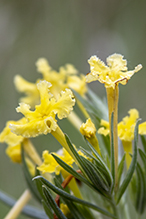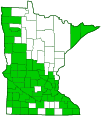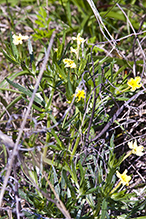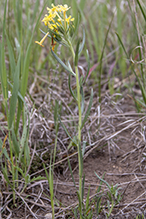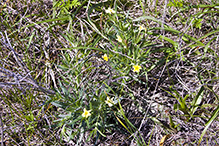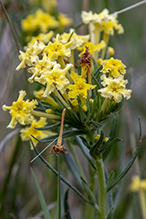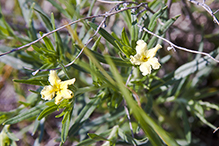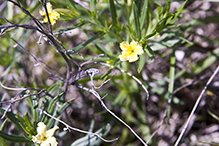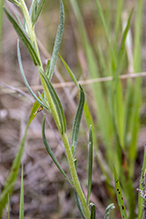fringed puccoon
(Lithospermum incisum)
Conservation • Description • Habitat • Ecology • Use • Distribution • Taxonomy
Conservation Status |
|
|||||||
| IUCN Red List | not listed |
|||||||
| NatureServe | N5? - Secure SNR - Unranked |
|||||||
| Minnesota | not listed |
|||||||
Description |
||
Fringed puccoon is a 4″ to 20″ tall, erect, perennial forb that rises on 1 or a few stems from a woody taproot. The stems are erect or ascending, unbranched in the spring, becoming sparsely to moderately branched later in the season. They are roughly hairy. The hairs on the stem have small, elevated, blister-like elevations (pustules) at the base. The leaves are numerous, alternate, stalkless, relatively thick, linear to narrowly lance-shaped, ¾″ to 2¾″ long, and ⅛″ to ¼″ wide. They are tapered at the base and tapered to a sharp point at the tip. There is a single prominent vein and no noticeable lateral veins. The upper and lower surfaces are grayish-green and roughly hairy. There are small, elevated, blister-like elevations (pustules) at the base of the hairs on the leaves, though this may not be apparent without a hand lens. The margins are untoothed and have a fringe of soft hairs. There are two kinds of flowers. In the early spring showy flowers are produced. In the late spring and summer unopened, bud-like flowers are produced. The early spring inflorescences are dense flower clusters at the end of the stem and branches. The flowers at the top bloom first, the lateral flowers progressively later. The clusters do not elongate as the season progresses. Early spring flowers are ⅓″ to ¾″ wide and funnel-shaped. The sepals are fused at the base into a short, cup-like structure (calyx) then separated into 5 linear, ¼″ to ½″ long lobes. The 5 petals are lemon yellow or bright yellow. They are fused at the base into a ¾″ to 2″ long floral tube, then separated into 5 spreading, ⅜″ to ¾″ wide lobes. The lobes are fringed. The flowers are subtended by leaf-like bracts that are much longer than the calyx. Most of these showy flowers are sterile. In the late spring and summer branches grow along the stem below the inflorescence. In the leaf axils of these new branches solitary, non-opening, self-pollinating (cleistogamous) flowers are produced. These flowers are highly fertile. The fruits are 1 to 4 egg-shaped, ⅛″ long, white, shiny, hard nutlets. They are smooth or have scattered pits or short grooves, mostly toward the base and along the keel. Each nutlet contains 1 seed. |
||
Height |
||
4″ to 20″ |
||
Flower Color |
||
Yellow |
||
Similar Species |
||
Hairy puccoon (Lithospermum caroliniense var. croceum) often rises on 12 or more stems. The inflorescence eventually becomes much longer, 2″ to 10″ long. The floral tube is much shorter, 9 ⁄16″ to 1″ long. The petals are not fringed. There are no cleistogamous flowers. Hoary puccoon (Lithospermum canescens) stems are less leafy. The leaves are densely, softly hairy, not rough. The hairs on the stem and leaves are not pustule-based, though this may not be apparent without a hand lens. The inflorescence eventually becomes much longer, 1″ to 4″ long. The flowers are smaller, ⅓″ to ½″ wide. The floral tube is much shorter, ¼″ to ⅜″ long. The petals are not fringed. The fruit is cream-colored, not white. There are no cleistogamous flowers. |
||
Habitat |
||
Dry. Prairies, barrens. In rocky, sandy soil. |
||
Ecology |
||
Flowering |
||
May to June |
||
Pests and Diseases |
||
|
||
Use |
||
|
||
Distribution |
||||
|
Sources |
|||
| 4/21/2023 | ||||
Nativity |
||||
Native |
||||
Occurrence |
||||
|
||||
Taxonomy |
|||
| Kingdom | Plantae (Plants) | ||
| Subkingdom | Pteridobiotina | ||
| Phylum | Tracheophyta (Vascular Plants) | ||
| Class | Magnoliopsida (Dicots) | ||
Order |
Boraginales (borages) | ||
Family |
Boraginaceae (borage) | ||
| Subfamily | Boraginoideae | ||
| Tribe | Lithospermeae | ||
Genus |
Lithospermum (stoneseeds, puccoons, and gromwells) | ||
Subordinate Taxa |
|||
|
|||
Synonyms |
|||
Batschia linearifolia Lithospermum angustifolium Lithospermum linearifolium Lithospermum mandanense |
|||
Common Names |
|||
fringed gromwell fringed puccoon narrowleaf gromwell narrowleaf puccoon narrowleaf stoneseed trumpet stoneseed |
|||
Glossary
Axil
The upper angle where the leaf stalk meets the stem.
Calyx
The group of outer floral leaves (sepals) below the petals, occasionally forming a tube.
Cleistogamous
Automatically self-pollinating. Refers to bud-like flowers that do not open but automatically self-pollinate, or to plants with such flowers.
Linear
Long, straight, and narrow, with more or less parallel sides, like a blade of grass.
Pustule
Small, elevated, blister-like elevations, usually at the base of hairs.
Sepal
An outer floral leaf, usually green but sometimes colored, at the base of a flower.

Visitor Videos |
|||
Share your video of this plant. |
|||
| This button not working for you? Simply email us at info@MinnesotaSeasons.com. Attach a video, a YouTube link, or a cloud storage link. |
|||
Other Videos |
|||

Visitor Sightings |
|||||
Report a sighting of this plant. |
|||||
| This button not working for you? Simply email us at info@MinnesotaSeasons.com. Be sure to include a location. |
|||||
|
|||||
MinnesotaSeasons.com Sightings |
|||||

|
Created: Last Updated: © MinnesotaSeasons.com. All rights reserved. |
